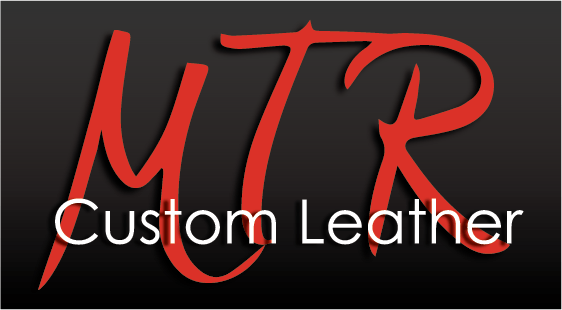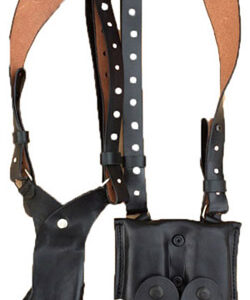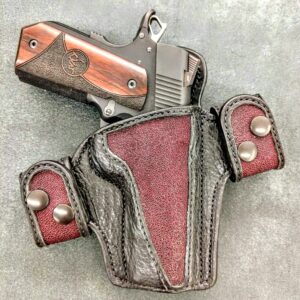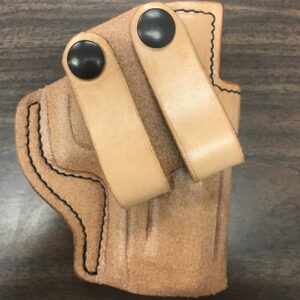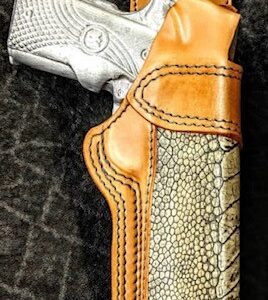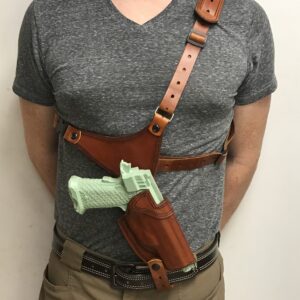Leather Paddle Holsters-What are they-how do you wear them?
We get to talk to customers most all day about holsters, and one of the holster styles that seems most confusing to people is the paddle holster.
The paddle holster gets its name from the paddle-shaped appendage that is attached to the holster. That appendage is worn inside the waistband, while the paddle holster is worn outside the belt. We understand that the paddle holster concept can be a little confusing, so here are a few images to help explain:
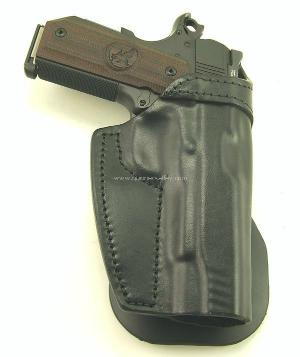 |
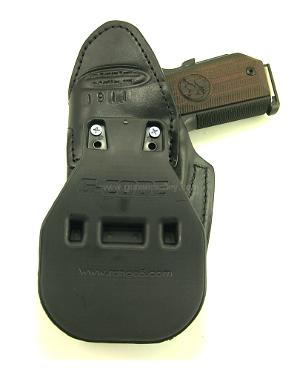 |
Click This Link To See All The Paddle Holster Models That We Currently Offer
So What is a Paddle Holster?
From an official definition or description standpoint, Wikipedia describes a paddle holster as:
“A paddle holster is a holster for a handgun whose method of securing the holster to the wearer utilizes a flat, concave shaped piece of plastic or stiffened leather designed to be worn against the body inside of the pants.”
For the most part, a paddle holster consists of two components:
- The holster
- The paddle
Let’s talk about each part separately:
Holster
The holster portion of paddle holsters is typically manufactured from one of three materials:
- Leather – Our personal favorite and still one of the most popular gun holster materials.
- Kydex – This thermoplastic material has become very popular as a gun holster material in the last 20 years. It’s an extremely durable material that is entirely waterproof but is vulnerable to high heat.
- Ballistic Nylon – This durable material is known for being extremely strong with high tensile strength. It’s less expensive to produce but doesn’t hold its form all that well.
Paddle
The paddles themselves can be produced from several materials. But the two most popular options are Kydex paddles or plastic paddles that are covered in leather or suede for additional comfort.
Most paddles are designed with a series of built-in appendages commonly called lips, ledges, or anchors. These appendages are designed to increase the amount of friction holding the holster to the body and serve as a grabbing or gripping point for the underside of a belt (if one is worn) to aid in stability and retention.
Paddle Holster – Pros and Cons
Like most things in life, paddle holsters offer some advantages and disadvantages. Let’s talk about the pros and cons of this holster style:
Pros
Easy to putting on or taking off – With the paddle portion being worn inside the waistband, the paddle holster is relatively easy to put on or take off. The user doesn’t have to remove the belt or even undo the pants in most cases, and that’s the most significant advantage that a paddle holster offers. That feature is what makes the paddle holster such a popular holster option.
Can potentially be worn without a belt – While many other holster styles are dependent on a belt to function, the paddle holster is the only outside the waistband holster style that is NOT dependent on a belt.
This feature makes the paddle holster a popular option with the ladies (as many do not utilize a belt in most everyday wear) and with clothing styles that are not belt friendly (think sweat pants, yoga pants, etc.). Now for the holster to be stable in these scenarios, the pants must have a reasonably firm waistband that rides tight to the body; otherwise, the holster will shift around and pull away from the body.
Cons
Not as stable as a belt holster – The paddle holster’s easy-on/easy-off features are a bit of a double-edged sword as they also mean that the paddle holster relies on the friction of the paddle inside the waist as an anchor point to keep the holster in place. This attachment method is not as stable as attaching the holster directly to the belt and can mean that the holster may shift on the waist.
Lacks the physical security of a belt holster – Most paddle holsters use a ledge, lip, or clip of some design to help with friction. To help grab onto the bottom of the belt, the holster itself isn’t physically attached to the belt like a traditional belt holster. As such, the paddle holster lacks the same physical security found on a belt holster with the gun belt attached through belt slots in the holster.
Concealability – While the paddle design offers an easier way to put the holster on or take it off compared to the traditional belt loop method, it doesn’t pull the holster as tight to the body as a belt holster. With the holster riding a little farther away from the body, paddle holsters can be more challenging to conceal compared to a traditional OWB belt holster.
Paddle Holster Options
Like most gun holster models, paddle holsters are available with various options or features that can be beneficial to the user. Some of the more popular options include the following:
Holster cant – The “cant” refers to the angle that the holster rides on the waist in relation to the user. The two most popular cants are commonly called straight-up cant or zero cant, and a forward cant. The forward cant angle varies with each holster brand, but most angle a forward cant model somewhere between 10 degrees and 15 degrees.
Some paddle holster models feature an adjustable cant that is adjusted to a 0 cant (straight up and down), forward cant, or even a 15-degree reverse cant for those that might want to wear the holster in a cross draw configuration.
Retention devices – While many paddle holster models are designed as open-top models with just passive retention, some are available with active retention devices.
Passive retention refers to the retention provided by the fit of the weapon into the holster, while active retention refers to a retention device that has to be activated or accessed for the handgun to be drawn from the holster.
The two most common types are:
- Thumb Break – A thumb break (also commonly called a retention strap, security strap, or retention break) is used to describe a strap device or hood device that goes over the handgun’s rear portion and is designed to help keep the firearm in the holster. The strap or hood has to be unsnapped, disengaged, or moved forward for the handgun to be drawn in most cases.
- Internal lock – Paddle holster models with an internal lock are designed with a locking mechanism that attaches to the handgun’s front trigger guard area within the holster. This lock has to be deactivated via a button or other mechanism to draw the handgun.
From a security level standpoint most commonly seen at the law enforcement level, these types of retention devices are usually assigned a numerical level. A holster with a single retention device is widely known as a Level 1 holster. A Level 2 holster would have two retention devices, while a Level 3 holster would have three retention devices.
Most paddle holsters only offer a maximum of Level 1 retention on the standard LEO retention scale. However, a few specialized paddle holster designs on the market are classified as Level 2.
Ride Height – Some paddle holster models on the market also offer an adjustable ride height. The user can adjust where the paddle attaches to the holster and control the height that the holster rides in relation to their belt or waistline.
FAQS
Here are some commonly asked questions that we see regarding paddle holsters:
Do you offer a paddle style holster to fit any pistols with lights mounted?
Yes, we carry the MTR Custom paddle holster, which is available to fit over 100 different handgun models with many popular weapon light models attached. That paddle holster model can be seen here.
I’m looking for a leather paddle type holster that uses a push-button style security release similar to the security lock on the Blackhawk Serpa holster?
Unfortunately, we don’t currently offer a leather paddle holster that features an internal lock or push button security release. All the paddle holsters that we offer use a thumb break as the retention device.
Do you have a paddle style holster model that features an adjustable cant?
We currently offer two holster brands that produce a paddle holster: Don Hume and MTR Custom. Of the two, only the MTR Custom model offers an adjustable cant. The cant on that model can be set up for straight-up cant, forward cant, or reverse forward cant for cross-draw carry. That model can be seen by following this link.
Do you have any leather paddle holster models?
At this time, we only offer holsters in leather, so all we have are leather paddle holster options.
Are paddle holsters any good?
The concept of something being either good or bad is based strictly on one’s opinion of what is good or bad. As that opinion is entirely subjective, the “good” or “bad” rating is relative.
Paddle holsters certainly have their place and fill a definite niche within the holster industry. Paddle holsters are quite popular due to their ease of being put on or taken off compared to a traditional belt holster, where you have to remove your belt to mount the belt holster.
Personally, we’ve always felt that paddle holsters were a good option for range use, general carry, or any situation where one has to take the holster on or off regularly.
Can you talk about how to wear a paddle style holster?
While a paddle holster may look complicated, they are relatively easy to wear. Most paddle holsters are designed to wear on the strongside (as in the same side as your shooting hand). The holster’s paddle portion is inserted down into the waistband and then slightly adjusted to the specific point where it rides comfortably. The actual holster portion then rides outside the waistband on the point where the paddle was inserted.
Are holsters with a paddle good for concealed carry?
Opinions on this topic are no different than opinions on any other gun-related topic. Ask ten different shooters, and you’ll most likely get ten varied answers.
Our opinion on this topic has been that paddle holsters can be a good option for concealed carry, but only under the right circumstances.
Due to their design, paddle holsters don’t ride as close to the body as a belt holster. As a result, paddle holsters don’t conceal all that well, and they are best suited for concealed carry use in colder climates where a cover garment can use used. In warmer weather, they do not conceal well with a light cover garment like a T-shirt.
However, for use with a sweatshirt, light jacket, or coat as a cover garment, they can work well for concealed carry.
ALL THE PADDLE HOLSTER MODELS THAT WE CARRY ARE LISTED BELOW.
https://www.mtrcustomleather.com/?s=paddle&post_type=product
